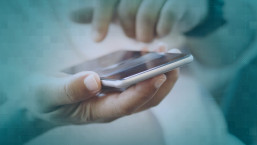Okay, you got the wrapping paper off the new tablet hotness, fired it up and now cannot put it down. But what should you be doing in the New Year to properly feed, protect, and care for your newly found addiction? Well here are some of the basics – things that are easy to do now and may prevent a lot of pain later.
 #1: Install the latest updates: As my colleague Aryeh Goretsky pointed out on a recent podcast, due to the supply chain behind the scenes, your “new” tablet was manufactured months ago and has taken a long rambling journey to reach the place where it was purchased. This means you’ll probably need to install patches and updates, even if it’s brand new to you. Be sure to patch using the native update utility for the device, but also pay attention to software like Java and Flash, which provide their own update path, outside of the regular operating system updates. Java has been the target of recent exploits because it tend to placed on the back burner update-wise, and exploits have bitten many users.
#1: Install the latest updates: As my colleague Aryeh Goretsky pointed out on a recent podcast, due to the supply chain behind the scenes, your “new” tablet was manufactured months ago and has taken a long rambling journey to reach the place where it was purchased. This means you’ll probably need to install patches and updates, even if it’s brand new to you. Be sure to patch using the native update utility for the device, but also pay attention to software like Java and Flash, which provide their own update path, outside of the regular operating system updates. Java has been the target of recent exploits because it tend to placed on the back burner update-wise, and exploits have bitten many users.
#2: Protect it from loss: Tablets are mobile by definition so keep in mind it’s very easy for thieves to swipe them at a moment’s notice if they’re left sitting in the top of a bag or on a table at a coffee shop while you pick up your latte. Tablets are likely to be a popular target for turning into quick cash through resale on the Internet or other channels. At the same time they can hold lots of personal data that you’d rather not share with others. So you might want to look into various tracking options using 3G and/or GPS features found on many tablets, enabling a remote locking and/or “phone home” setup that lets you freeze a thief out of the device and possibly help locate it so you can it back.
#3: Automate your backups: The last thing you want after spending a half year collecting e-books, addresses, documents and music, is to have to start over. Many tablet offerings have a cloud-based backup that can be scheduled so you don’t have to think of it, it just happens. This is a convenient way to go – if you trust the cloud as a place to store your personal data. For those who want something more private, there are apps for automating backups over your home network to a hard drive you can see, touch, and securely store. You may even be able to back up your data to a Micro SDHC card in the tablet (be sure to remove and store it in a safe location when done with your backup, though). Backups are like eating veggies, we all know we should do more, but it may not be the most exciting thing to think about. Just find something that works for you. It doesn’t have to be perfect, but if it safely protects your data without you thinking about it much, you’ll be very, very thankful later if something bad happens.
#4: Think before you install: With the bewildering number of apps available for modern tablets, the tendency to flood your tablet with apps can be seductive. Don’t give in. We all remember the first computer we owned, where we installed everything, clicked on everything, and then had to re-format and start over a few months later as things slowed to a crawl. Less is more on your tablets. Also, keep in mind your tablet has much of the full operating system power and sophistication of the average computer a few years ago. That means scammers are eyeing the tablets for all sorts of nasty schemes. The more apps you have, the more potential for holes that allow intruders access. Just be careful. Also, install from the official app source for your tablet and resist the urge to install from third-party websites that tend to be patrolled less rigorously for rogue applications.
 #5: Social Networking: If you use your tablet for social networking or email it won't be long before the device contains a lot of valuable credentials. To prevent someone abusing those credentials, some networks, such as Facebook, provide a system for notifying you if someone tries to access your account from an unrecognized device. It makes sense to enable this type of feature and in Facebook you do so via your Account Settings, choosing Security, then clicking on Login Approvals. Check where it says: "Require me to enter a security code each time an unrecognized computer or device tries to access my account." Also enable Login Notifications. Now you will get the chance to register each of your computers or mobile devices with Facebook the first time you connect from them. You register them using a code that Facebook sends via SMS to your cell phone. You can deregister devices whenever you like and check on which devices are logged into Facebook at any time.
#5: Social Networking: If you use your tablet for social networking or email it won't be long before the device contains a lot of valuable credentials. To prevent someone abusing those credentials, some networks, such as Facebook, provide a system for notifying you if someone tries to access your account from an unrecognized device. It makes sense to enable this type of feature and in Facebook you do so via your Account Settings, choosing Security, then clicking on Login Approvals. Check where it says: "Require me to enter a security code each time an unrecognized computer or device tries to access my account." Also enable Login Notifications. Now you will get the chance to register each of your computers or mobile devices with Facebook the first time you connect from them. You register them using a code that Facebook sends via SMS to your cell phone. You can deregister devices whenever you like and check on which devices are logged into Facebook at any time.
#6: Security software: As noted above in #4, there is small-but-growing amount malicious software for tablets. Some tablet vendors, screen software for malicious behavior before allowing it into their stores, while others allow you to directly install software. Even for the former, it is always possible that a malicious app will slip through the screening process. Many antimalware vendors, including ESET, now offer versions of their security software which run on tablet operating systems like Google Android.
Follow these steps and you’ll have far less to worry about in the future as you invest time and effort putting content on your tablet device. Adopting sensible practices right away will give you peace-of-mind using your tablet now, and help you stay safe online for a long time to come.




